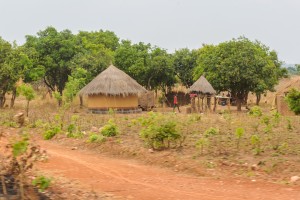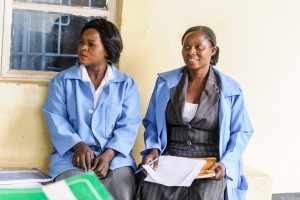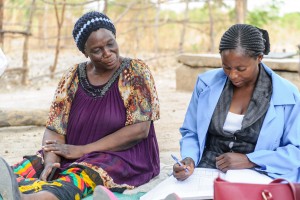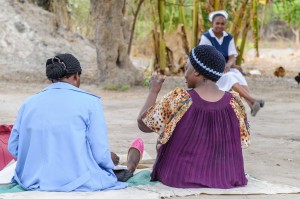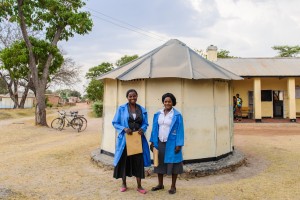In Chibombo District, part of Zambia’s Central Province north of the capital of Lusaka, Josephine Mwita lives in a small mud house a few hundred yards down well-worn dirt paths from the main road with 10 members of her family. Here in this rural area, most people make their living by farming and animal rearing.

Local Community Health Assistants (CHAs) Nelly Mwandila, 31, and Veronica Pansi, 39, visit Josephine’s household monthly to collect information and provide health education, sanitation inspection, and related feedback to the family. During this visit, Veronica sits with Josephine on a straw mat under a large shady tree in the yard and opens her register book, where she records census and health-related data about each household in the community. She marks the names and ages of everyone living in the house, asking about their well-being. Together they inspect the rubbish pit on the outskirts of the property, noting that it will soon need to be filled in and a new one dug since it is nearly full. They also discuss nutrition and diet in the household. Since they have provided her with information during past visits, Josephine is able to recall the three types of important nutrients food should have: “protein for growth, vegetable for illness prevention, and carbohydrates for energy,” she says. “Especially for my young grandson.”

Zambia’s sparsely populated landscape in places like Chibombo District poses serious challenges to health, as many people living in hard-to-reach areas are unable to access primary healthcare. Additionally, the country has a shortage of health workers in rural areas, including doctors, nurses, and midwives. To address these challenges, evidence shows that introducing high-impact community-level interventions—addressing the most prevalent diseases such as malaria, pneumonia, diarrhea, and maternal and newborn complications—can save many lives. Community health workers are at the front line of these proven interventions, as they have specific knowledge of communities, and familiarity with populations and their health issues.

Therefore, with support from the UK Department for International Development (DFID) and in close partnership with the Government of Zambia (GRZ), CHAI has been supporting the establishment, training, and deployment of a new paid government cadre of Community Health Assistants (CHAs) since 2011. As a major part of the country’s effort to address population health concerns in the communities where people live, CHAs are a cadre of health workers who are based at health posts and recruited from communities where they reside. They are trained for one year in primary healthcare and are deployed at health posts located within their communities, though they spend 80 percent of their time away from health posts visiting households. There, the CHAs educate the community about topics like sanitation, such as drinking clean boiled water and having a properly designed toilet, hand washing facilities, and rubbish pit to dump trash, as well as health-seeking behavior, emphasizing the importance of accessing health care early on when symptoms present. They are also trained to promote and monitor disease prevention, particularly the need to use mosquito nets to protect against malaria, and measures intended to limit diarrheal disease among children.

The nurse in charge of Nelly and Veronica, Dorothy Nkomanga Mungule, says she’s found the CHAs to be “committed, so helpful, and mature.” “They ask questions and are very teachable,” she continues. Generally, during the 20 percent time that they spend at the facility, they focus on maternal health, growth monitoring and vaccination screening for children under 5, and disease prevention efforts.

The CHA program is continually monitored and improved to ensure it is best serving Zambia’s population. In 2015 CHAI and partners completed a process evaluation for the CHA program in order to improve services; the results drove a curriculum review and provincial level trainings for CHA supervisors like Dorothy in May 2016 to align them with emerging public health priorities in the country. The new curriculum will be used from January 2017.
The CHA supervision and mentoring trainings are being rolled out to all 10 provinces of the country. Increased supervision of the CHAs is expected to improve the quality of services provided by the CHAs.

As of September 2016, 1,403 CHAs have been trained and deployed across 597 health posts throughout Zambia, serving around 4 million people. Additionally, the country’s two CHA training schools graduate at least 500 CHAs annually. These newly educated CHAs will be deployed as they graduate, further expanding the benefit of their services, which are expected to reduce disease burden and improve population health, particularly in rural areas where over 60 percent of the Zambian population lives.

Written by Prudence Haimbe, Program Manager, Community Health Assistants and Tina Damalas
